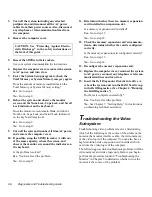
Checking Inside Your Computer
6-15
9.
Check the hard-disk drive’s jumpers and the con-
troller card’s jumpers (if a controller card is
installed). (For an Industry-Standard Architec-
ture [ISA] card, check the settings on the card
itself; for an Extended Industry-Standard Archi-
tecture [EISA] card, check the settings through
the EISA Configuration Utility.)
For a description of the jumper settings for the drive
or controller card, see the documentation for the
drive or controller card.
Are the jumpers positioned correctly?
Yes. Go to step 11.
No. Go to step 10.
10. Correct the jumper settings for the drive and/or
controller card as instructed by the documenta-
tion for the drive and reinstall the hard-disk
drive.
11. Replace the computer cover, reconnect the system
to AC power, reconnect any telephone or telecom-
munication lines to the computer, and turn on the
computer.
12. Listen for the drive spinning up after the power
supply turns on.
Can you hear the drive spinning up?
Yes. Go to step 13.
No. Go to step 14.
13. Partition and logically format the hard-disk
drive. If possible, restore the files to the drive.
To partition and logically format the drive, see the
documentation for the computer’s operating system.
Is the problem resolved?
Yes. The hard-disk drive’s file structure was proba-
bly corrupt. You have fixed the problem.
No. Go to step 14.
14. See Chapter 7, “Getting Help,” for instructions
on obtaining technical assistance.
Troubleshooting SCSI Hard-Disk Drives
in a System Without a SCSI Backplane
Board
Use the following procedure to troubleshoot a hard-disk
drive problem if your system includes one or more SCSI
hard-disk drives and does not contain a SCSI backplane
board.
1.
Boot the system from a diskette, and enter the
System Setup program.
Are both of the hard-disk drive categories set to
None?
Refer to your system documentation for more infor-
mation about the hard-disk drive categories.
Yes. Go to step 3.
No. Go to step 2.
2.
Change both categories to None, and reboot the
system.
Is the problem resolved?
Yes. The system configuration settings were set
incorrectly. You have fixed the problem.
No. Go to step 3.
3.
Verify that any required SCSI device drivers are
installed and configured correctly.
If the system is using the built-in SCSI host adapter
or the DASH Bus Adapter card, see the SCSI Device
Driver Installation and Configuration Guide to
determine which drivers are required and how they
should be installed and configured.
Are the required SCSI device drivers installed and
configured correctly?
Yes. Go to step 5.
No. Go to step 4.
CAUTION: This troubleshooting procedure can
destroy data stored on the hard-disk drive. Before
you proceed, make sure you have backed up all the
files on your hard-disk drive.
Summary of Contents for OptiPlex HUB
Page 1: ... 1267 6 1 7528 6 227 1 8 ...
Page 2: ......
Page 3: ... 1267 6 1 7528 6 227 1 8 ...
Page 10: ...x ...
Page 18: ...xx DELL CONFIDENTIAL Preliminary 2 10 98 ...
Page 20: ...xxii DELL CONFIDENTIAL Preliminary 2 10 98 ...
Page 38: ...2 14 Diagnostics and Troubleshooting Guide ...
Page 42: ...3 4 Diagnostics and Troubleshooting Guide ...
















































